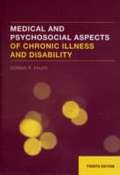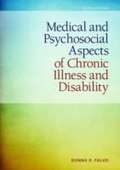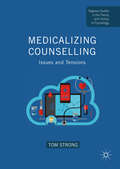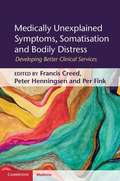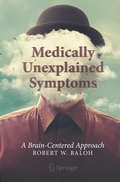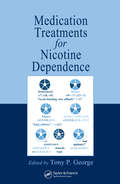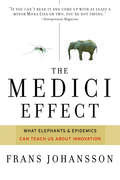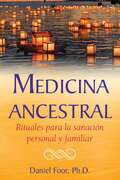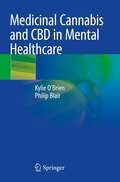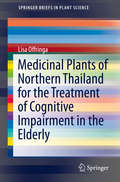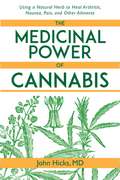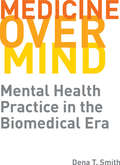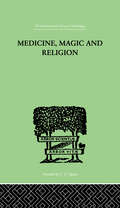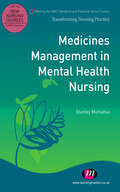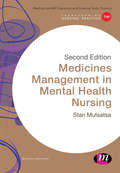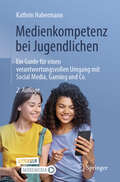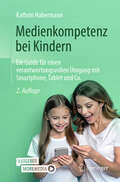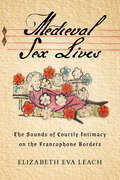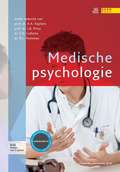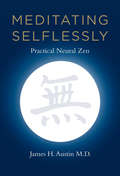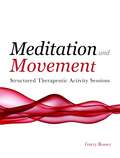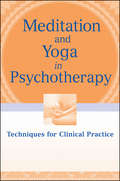- Table View
- List View
Medical and Psychosocial Aspects of Chronic Illness and Disability (4th Edition)
by Donna R. FalvoMedical and Psychosocial Aspects of Chronic Illness and Diseases, Fourth Edition covers the medical aspects of those conditions commonly encountered by rehabilitation and other health professionals and discusses symptoms, diagnoses, treatments, and prognoses. This Fourth Edition has been completely revised and updated and reflects an approach consistent with the philosophical underpinnings of the International Classification of Functioning, Disability and Health (ICF). New chapters on Conceptualizing Chronic Illness and Disability; Intellectual Disability; and Financing Rehabilitation have been added. In addition, chapters on Psychiatric Disability, Substance Use, and Conditions of the Blood and Immune System have been expanded
Medical and Psychosocial Aspects of Chronic Illness and Disability (Fifth Edition)
by Donna R. FalvoThis book is designed as a reference for non-medical professionals and as a text for students who have little prior medical knowledge but who work with individuals with chronic illness and disability.
Medicalizing Counselling
by Tom StrongThis book discusses how counselling, a profession known for diverse and innovative practices, has recently been influenced by scientific, marketplace, and administrative developments corresponding with a medicalized focus on psychiatric diagnoses and related evidence-based treatments. Tensions associated with this medicalized focus refer to competing logics and accountabilities regarding how to understand and address concerns brought to counselling. Tom Strong reviews such tensions as they relate to counsellors’ approaches to practice experienced as incompatible with a medicalized approach. The role of media and technology, therapy culture, and counsellor education, are examined with respect to medicalizing tensions that professionals and clients of counselling increasingly face. The book will interest readers who share concerns regarding the potential for a mental health monoculture grounded in the diagnose and treatment logic of medicalized counselling.
Medicalizing Ethnicity: The Construction of Latino Identity in a Psychiatric Settings
by Vilma Santiago-IrizarryIn Medicalizing Ethnicity, Vilma Santiago-Irizarry shows how commendable intentions can produce unintended consequences. Santiago-Irizarry conducted ethnographic fieldwork in three bilingual, bicultural psychiatric programs for Latino patients at public mental health facilities in New York City. The introduction of "cultural sensitivity" in mental health clinics, she concludes, led doctors to construct essentialized, composite versions of Latino ethnicity in their drive to treat mental illness with sensitivity. The author demonstrates that stressing Latino differences when dealing with patients resulted not in empowerment, as intended, but in the reassertion of Anglo-American standards of behavior in the guise of psychiatric categories by which Latino culture was negatively defined. For instance, doctors routinely translated their patients' beliefs in the Latino religious traditions of espiritismo and Santeria into psychiatric terms, thus treating these beliefs as pathologies. Interpreting mental health care through the framework of culture and politics has potent effects on the understanding of "normality" toward which such care aspires. At the core of Medicalizing Ethnicity is the very definition of multiculturalism used by a variety of institutional settings in an attempt to mandate equality.
Medically Unexplained Symptoms, Somatisation and Bodily Distress
by Francis Creed Peter Henningsen Per FinkMedically unexplained symptoms and somatisation are the fifth most common reason for visits to doctors in the USA, and form one of the most expensive diagnostic categories in Europe. The range of disorders involved includes irritable bowel syndrome, chronic widespread pain and chronic fatigue syndrome. This book reviews the current literature, clarifies and disseminates clear information about the size and scope of the problem, and discusses current and future national and international guidelines. It also identifies barriers to progress and makes evidence-based recommendations for the management of medically unexplained symptoms and somatisation. Written and edited by leading experts in the field, this authoritative text defines international best practice and is an important resource for psychiatrists, clinical psychologists, primary care doctors and those responsible for establishing health policy.
Medically Unexplained Symptoms: A Brain-Centered Approach
by Robert W. BalohDespite the rapid advances in medical science, the majority of people who visit a doctor have medically unexplained symptoms (MUS), symptoms that remain a mystery despite extensive diagnostic studies. The most common MUS are back pain, abdominal pain, headache, fatigue, and dizziness. This book addresses the obstacles of managing people with MUS in our modern day society from both a historical and contemporary perspective.Most MUS are psychosomatic in origin, caused by a complex interaction between nature and nurture, between biological and psychosocial factors. Psychosomatic symptoms are as real and as severe as the symptoms associated with structural damage to the brain. Unique and concise, the book explores the biological and psychosocial mechanisms, the clinical features, and current and future treatments of common MUS. Exploring the unsolved in an accessible manner, Medically Unexplained Symptoms invokes the methodologies of medical science, history, and sociology to investigate how brain flaws can lead to debilitating symptoms.
Medication Treatments for Nicotine Dependence
by Tony P. GeorgeDespite the prevalence of both pharmaceutical and behavioral approaches to encourage cessation, over a billion people still indulge in tobacco. Even in the U.S., where tobacco use is considered a clearly treatable and socially regrettable condition, a significant percentage of individuals remain resistant to treatment modalities. It is believed tha
Medici Effect
by Frans JohanssonWhy do so many world-changing insights come from people with little or no related experience? Charles Darwin was a geologist when he proposed the theory of evolution. And it was an astronomer who finally explained what happened to the dinosaurs.Frans Johansson's The Medici Effect shows how breakthrough ideas most often occur when we bring concepts from one field into a new, unfamiliar territory, and offers examples how we can turn the ideas we discover into path-breaking innovations.
Medicina ancestral: Rituales para la sanación personal y familiar
by Daniel Foor• Proporciona ejercicios y rituales para iniciar el contacto con tus antepasados, encontrar guías ancestrales y ayudar a los fallecidos que aún no están en paz • Explica cómo emprender el trabajo de reparación del linaje de forma segura, al conectar con tus antepasados más antiguos antes de relacionarte con los recién fallecidos • Explora cómo tus antepasados pueden ayudarte a transformar los legados intergeneracionales de dolor y abuso, así como a recuperar el espíritu positivo de la familia Todos tenemos antepasados sabios a quienes podríamos invocar para recibir apoyo. Daniel Foor detalla cómo relacionarse con antepasados a través de ejercicios basados en antiguas tradiciones de sabiduría para iniciar el contacto, encontrar guías de apoyo, armonizar tus líneas de sangre y ayudar a los fallecidos que aún no están en paz. La guía muestra cómo recuperar las bendiciones y dones de los linajes para lograr avances curativos de los miembros vivos y librar a las generaciones futuras de cargas ancestrales. Foor describe formas de honrar a los ancestros, abordar visitas oníricas de los muertos, trabajar con santuarios y llevar a cabo ritos funerarios. A través de la reverencia a los antepasados descubrirás cómo mantener las conexiones con familiares queridos después de su muerte y entender mejor la relación entre los vivos y los muertos.
Medicinal Cannabis and CBD in Mental Healthcare
by Kylie O'Brien Philip BlairThis book functions as a clinician’s guide to the use of cannabidiol (CBD) in the treatment of mental health conditions. It conveys the scientific evidence of efficacy of CBD as well as THC and addresses the social stigma attached to its medical use.The book describes the endocannabinoid system, how stress and the endocannabinoid system interact and key constituents, pharmacokinetics and safety aspects of medicinal cannabis, focusing on CBD and THC. Chapters on specific mental health conditions describe the underpinning pathomechanisms including how the endocannabinoid system is involved, and summarises the scientific evidence including animal and human research for the use of CBD and THC in treatment of such conditions. Topics covered include anxiety, depression, post-traumatic stress disorder, insomnia, Alzheimer's Disease and autism spectrum disorder. Chapters also discuss treatment guidelines and case studies. Unique and focused, Medicinal Cannabis and CBD in Mental Healthcare is an invaluable reference for medical practitioners seeking to adopt CBD-use in their treatment plans.
Medicinal Plants of Northern Thailand for the Treatment of Cognitive Impairment in the Elderly
by Lisa OffringaThis book provides a description of cognitive impairment in the elderly population through the lens of Thai Traditional Medicine as it is practiced in northern Thailand. It provides an overview of Thai Traditional Medicine and the memory loss presented in elderly dementia. Some medicinal plants used by traditional Thai healers to treat cognitive decline and memory issues in the elderly are reviewed. Medicinal Plants of Northern Thailand for the Treatment of Cognitive Impairment in the Elderly provides readers with the detailed description of the in vitro screening of ten plants and those results. The bioactivity of these single plants exemplifies the success of using an ethnobotanical filter to identify plants with cognitive enhancing activity.
Medicinal Power of Cannabis: Using a Natural Herb to Heal Arthritis, Nausea, Pain, and Other Ailments
by John HicksIt's no surprise that marijuana has healing powers, but whether or not using it to treat common ailments should be legalized continues to be a hot topic of debate among government leaders and medical practitioners alike. Marijuana comes from the cannabis plant, an herb whose leaves can be extracted and used as a recreational drug, allowing users to feel a euphoric high. But the cannabis plant has many non-psychoactive properties as well. Cannabidiol, also known as CBD is a substance extracted from the cannabis plant that has been proven to have all the healing powers of marijuana without the psychoactive properties. With over thirty years of experience in integrated holistic health, Dr. John Hicks presents here his extensive knowledge and research. In this revolutionary book, Dr. Hicks touches on an area of holistic health that many medical practitioners have over looked in the past. He begins by explaining the root cause of most diseases--inflammation--and then illustrates how inflammation progresses into the various diseases and ailments that plague us. Finally, he shows how CBD can stop the inflammation and heal the problem. CBD has been shown to help: Anxiety Alzheimer's disease Seizures Huntington's disease Nausea and vomiting And much, much more With information ranging from easy-to-understand terminology to scientific studies based on Hick’s decades of experience in integrative medicine, this book has a little bit of something for everyone, from your typical hypochondriac to the seasoned medical practitioner.
Medicine over Mind: Mental Health Practice in the Biomedical Era (Critical Issues in Health and Medicine)
by Dena T. SmithWe live in an era in which medicalization—the process of conceptualizing and treating a wide range of human experiences as medical problems in need of medical treatment—of mental health troubles has been settled for several decades. Yet little is known about how this biomedical framework affects practitioners’ experiences. Using interviews with forty-three practitioners in the New York City area, this book offers insight into how the medical model maintains its dominant role in mental health treatment. Smith explores how practitioners grapple with available treatment models, and make sense of a field that has shifted rapidly in just a few decades. This is a book about practitioners working in a medicalized field; for some practitioners this is a straightforward and relatively tension-free existence while for others, who believe in and practice in-depth talk therapy, the biomedical perspective is much more challenging and causes personal and professional strains.
Medicine, Magic and Religion: The FitzPatrick Lectures delivered before The Royal College of Physicians in London in 1915-1916 (International Library Of Psychology Ser. #Vol. 35)
by W. H. RiversFirst Published in 1999. Routledge is an imprint of Taylor & Francis, an informa company.
Medicines Management in Mental Health Nursing
by Stanley MutsatsaMental-health nurses must develop the crucial skills of correct medicines management and calculations in order to provide safe care to their patients. This book specifically supports pre-registration students in meeting the required competencies for medicines management. It has a strong emphasis on understanding the role of medicine as one of a range of treatment options, and collaborative working with patients and carers. It is clearly structured around the NMC Essential Skills Clusters for medicines management, covering law, drugs calculations, administration, storage, record keeping, introductory pharmacology, patient communication and contextual issues.
Medicines Management in Mental Health Nursing (Transforming Nursing Practice)
by Stanley MutsatsaMedicines are a crucial part of the jigsaw when considering how to provide recovery-focussed care in mental health. It is important that mental health nurses understand how psychiatric drugs work, what the common treatments are and appreciate the ethical and legal dimensions that affect how medicines can and should be used in mental health care. Using innovative activities and real-life case studies, this book has been carefully designed to provide all this and more making it the ideal resource to build knowledge and confidence in this crucial area of practice. Key features · Clear explanations of both the underlying biology and pharmacology as well as the wider practicalities of working with medicines · Provides accessible information on the most common conditions and treatments · Linked to the NMC standards and essential skills clusters · Activities and case studies help students to apply what they have learnt to practice and consider the full impact that medicines will have on service users
Medienkompetenz bei Jugendlichen: Ein Guide für einen verantwortungsvollen Umgang mit Social Media, Gaming und Co.
by Kathrin HabermannSurfen, Zocken, Posten, Streamen Haben Sie sich schon einmal gefragt, was Snapchat eigentlich wirklich ist und wie Social Media Apps Geld mit Daten verdienen? Oder wie gefährlich Online-Games wirklich sind beziehungsweise, ob sie sogar Vorteile für die Entwicklung bieten? Worauf sollte man beim Thema Datenschutz konkret achten? Wie sieht eine gelungene Anleitung zum Umgang mit digitalen Medien aus? Wie kann man ChatGPT erfolgreich in den Schulalltag integrieren? Erfahren Sie in diesem Ratgeber für Eltern, Pädagog*innen und Therapeut*innen, was Jugendliche selbst über ihren Medienkonsum denken und welche Medienkompetenzen heute notwendig sind, um gesellschaftlich nicht den Anschluss zu verlieren. Aus dem Inhalt: Auswirkungen digitaler Medien auf Gehirnentwicklung, Konzentration und Suchtverhalten von Jugendlichen, Einsatz digitaler Medien in Schulen, Chancen und Risiken von Social Media und Gaming, Onlinehandel und Datenschutz, Richtlinien zur gesunden Screentime und Anlaufstellen für Eltern. Plus Material- und Spiellisten, Mediennutzungsvertrag und mehr zum Download und als Kopiervorlage. Diese 2. Auflage ist komplett überarbeitet und aktualisiert mit der neuesten Literatur und Studienlage.
Medienkompetenz bei Kindern: Ein Guide für einen verantwortungsvollen Umgang mit Smartphone, Tablet und Co.
by Kathrin HabermannDieser Ratgeber unterstützt Eltern, Pädagog*innen und Therapeut*innen dabei, die Faszination von Smartphones für Kinder zu verstehen, die Bedeutung von Langeweile zu erkennen und ihren Kindern einen verantwortungsvollen Umgang mit digitalen Medien zu vermitteln. Lernen Sie, wie Sie mit der ständigen Präsenz von Smartphones, Tablets und Co. gelassen und kreativ umgehen können und welche wissenschaftlichen Erkenntnisse zu diesem Thema relevant für die Entwicklung Ihres Kindes sind. Bieten Sie Kindern attraktive Alternativen und zahlreiche einfache Spiele für den täglichen Gebrauch. Entdecken Sie spannende und entwicklungsfördernde Aktivitäten, die wenig Material und kaum Vorbereitungszeit erfordern. Erhalten Sie Praxistipps für herausfordernde Situationen wie Restaurantbesuche, lange Autofahrten oder Bahnreisen. Nach diesem Ratgeber sind Sie bestens vorbereitet. Plus: Wissenschaftliche Hintergründe und aktuelle Studien übersichtlich und verständlich aufbereitet, Fragebögen und Checklisten zur Ermittlung des Medienkonsums, Material- und Spiellisten, Mediennutzungsvertrag und mehr zum Download und als Kopiervorlage.
Medieval Misogyny and the Invention of Western Romantic Love
by Bloch R. HowardUntil now the advent of Western romantic love has been seen as a liberation from-or antidote to-ten centuries of misogyny. In this major contribution to gender studies, R. Howard Bloch demonstrates how similar the ubiquitous antifeminism of medieval times and the romantic idealization of woman actually are. Through analyses of a broad range of patristic and medieval texts, Bloch explores the Christian construction of gender in which the flesh is feminized, the feminine is aestheticized, and aesthetics are condemned in theological terms. Tracing the underlying theme of virginity from the Church Fathers to the courtly poets, Bloch establishes the continuity between early Christian antifeminism and the idealization of woman that emerged in the twelfth and thirteenth centuries. In conclusion he explains the likely social, economic, and legal causes for the seeming inversion of the terms of misogyny into those of an idealizing tradition of love that exists alongside its earlier avatar until the current era. This startling study will be of great value to students of medieval literature as well as to historians of culture and gender.
Medieval Sex Lives: The Sounds of Courtly Intimacy on the Francophone Borders
by Elizabeth Eva LeachMedieval Sex Lives examines courtly song as a complex cultural product and social force in the early fourteenth century, exploring how it illuminates the relationship between artistic production and the everyday lives of the elites for whom this music and poetry was composed and performed. In a focused analysis of the Oxford Bodelian Library's Douce 308 manuscript—a fourteenth-century compilation that includes over five hundred Old French lyrics composed over two centuries alongside a narrative account of elaborate courtly festivities centered on a week-long tournament—Elizabeth Eva Leach explores two distinct but related lines of inquiry: first, why the lyric tradition of "courtly love" had such a long and successful history in Western European culture; and, second, why the songs in the Bodleian manuscript would have been so important to the book's compilers, owners, and readers. The manuscript's lack of musical notation and authorial attributions make it unusual among Old French songbooks; its arrangement of the lyrics by genre invites inquiry into the relationship between this long musical tradition and the emotional and sexual lives of its readers. Combining an original account of the manuscript's contents and their likely social milieu with in-depth musical and poetic analyses, Leach proposes that lyrics, whether read or heard aloud, provided a fertile means of propagating and enabling various sexual scripts in the Middle Ages. Drawing on musicology, literary history, and the sociology and psychology of sexuality, Medieval Sex Lives presents a provocative hypothesis about the power of courtly songs to model, inspire, and support sexual behaviors and fantasies.
Medische psychologie (Quintessens)
by A. A. Kaptein J. B. Prins E. H. Collette R. L. HulsmanMedische psychologie vormt een belangrijk aspect van de moderne geneeskunde. Bij gezond blijven, ziek worden, hulp zoeken bij klachten, diagnostische procedures, behandeling en nazorg (revalidatie) zijn niet alleen medische factoren van belang. Ook gedrag speelt hierin een cruciale rol. Psychologie is de wetenschap die zich bezighoudt met de bestudering van gedrag. Medische psychologie richt zich specifiek op het gedrag van mensen in de medische situatie. Medische psychologie geeft een helder overzicht van de kernthema's in de medische psychologie. Het boek is ingedeeld volgens de drie thema's van het vak: Gedrag en gezondheid, Gedrag en ziekte en Communicatie en professioneel gedrag. Aan de orde komen de psychologische aspecten van de belangrijkste diagnoses en therapieën bij gezondheidsproblemen. Er wordt stilgestaan bij vragen als: Welk gedrag leidt tot ziekte? Hoe reageren patiënten op een diagnose of een therapie? Wat zijn de psychische en sociale gevolgen van een ziekte of een behandeling? Aan welke eisen moet het gedrag van artsen voldoen in de omgang met patiënten? Deze onderwerpen worden geïllustreerd aan de hand van herkenbare voorbeelden uit de praktijk. Extra materiaal wordt aangeboden op de website bij het boek die voor de lezer kosteloos toegankelijk is. Beschikbaar zijn samenvattingen, verdiepingsvragen en zelfstudieopdrachten, links naar beeldmateriaal en interessante sites en PowerPoints speciaal voor docenten. Tevens is de gehele inhoud van dit boek op de website geplaatst zodat het overal online te raadplegen en snel te doorzoeken is. Extra materiaal wordt aangeboden op de website bij het boek die voor de lezer kosteloos toegankelijk is. Beschikbaar zijn samenvattingen, verdiepingsvragen en zelfstudieopdrachten, links naar beeldmateriaal en interessante sites en PowerPoints speciaal voor docenten. Tevens is de gehele inhoud van dit boek op de website geplaatst zodat het overal online te raadplegen en snel te doorzoeken is.
Medische psychologie (Quintessens)
by A. A. Kaptein J. B. Prins E. H. Collette R. L. HulsmanMedische psychologie vormt een belangrijk aspect van de moderne geneeskunde. Bij gezond blijven, ziek worden, hulp zoeken bij klachten, diagnostische procedures, behandeling en nazorg (revalidatie) zijn niet alleen medische factoren van belang. Ook gedrag speelt hierin een cruciale rol. Psychologie is de wetenschap die zich bezighoudt met de bestudering van gedrag. Medische psychologie richt zich specifiek op het gedrag van mensen in de medische situatie. Medische psychologie geeft een helder overzicht van de kernthema's in de medische psychologie. Het boek is ingedeeld volgens de drie thema's van het vak: Gedrag en gezondheid, Gedrag en ziekte en Communicatie en professioneel gedrag.Aan de orde komen de psychologische aspecten van de belangrijkste diagnoses en therapieën bij gezondheidsproblemen. Er wordt stilgestaan bij vragen als: Welk gedrag leidt tot ziekte? Hoe reageren patiënten op een diagnose of een therapie? Wat zijn de psychische en sociale gevolgen van een ziekte of een behandeling? Aan welke eisen moet het gedrag van artsen voldoen in de omgang met patiënten? Deze onderwerpen worden geïllustreerd aan de hand van herkenbare voorbeelden uit de praktijk. Extra materiaal wordt aangeboden op de website bij het boek die voor de lezer kosteloos toegankelijk is. Beschikbaar zijn samenvattingen, verdiepingsvragen en zelfstudieopdrachten, links naar beeldmateriaal en interessante sites en PowerPoints speciaal voor docenten. Tevens is de gehele inhoud van dit boek op de website geplaatst zodat het overal online te raadplegen en snel te doorzoeken is.Extra materiaal wordt aangeboden op de website bij het boek die voor de lezer kosteloos toegankelijk is. Beschikbaar zijn samenvattingen, verdiepingsvragen en zelfstudieopdrachten, links naar beeldmateriaal en interessante sites en PowerPoints speciaal voor docenten. Tevens is de gehele inhoud van dit boek op de website geplaatst zodat het overal online te raadplegen en snel te doorzoeken is.
Meditating Selflessly: Practical Neural Zen
by James H. AustinA guide to Zen meditative practice informed by the latest findings in brain research. This is not the usual kind of self-help book. Indeed, its major premise heeds a Zen master's advice to be less self-centered. Yes, it is "one more book of words about Zen," as the author concedes, yet this book explains meditative practices from the perspective of a "neural Zen." The latest findings in brain research inform its suggestions. In Meditating Selflessly, James Austin—Zen practitioner, neurologist, and author of three acclaimed books on Zen and neuroscience—guides readers toward that open awareness already awaiting them on the cushion and in the natural world. Austin offers concrete advice—often in a simplified question-and-answer format—about different ways to meditate. He clarifies both the concentrative and receptive styles of meditation. Drawing widely from the exciting new field of contemplative neuroscience, Austin helps resolve an ancient paradox: why both insight wisdom and selflessness arise simultaneously during enlightened states of consciousness.
Meditation and Movement: Structured Therapeutic Activity Sessions
by Garry RosserMeditation and Movement is an accessible series of structured relaxation and self-awareness sessions to help strengthen students' self-control, resilience and respect for both themselves and others. This course of fourteen one-hour structured sessions is suitable for groups of children, teens and youths, and especially beneficial for, but not limited to, use in schools with pupils with disabilities, special educational needs, self-esteem issues or behavioural difficulties. The course combines skills from different disciplines, and includes: meditation practices; therapeutic writing and talking tasks; movement and psychodrama play activities; and breathing, posture and movement techniques found in some martial arts. Complete with clear and full instructions and photocopiable worksheets, Meditation and Movement is straightforward enough for any enthusiastic non-'expert' leader to use with ease. An ideal course text for school teachers, school counsellors and psychologists, these structured sessions will also appeal to a variety of societies and associations, such as Buddhist, martial arts and drama groups.
Meditation and Yoga in Psychotherapy
by C. Alexander Simpkins Annellen M. SimpkinsPraise for Meditation and Yoga in Psychotherapy"From the wisdom of ancient cultures to modern neuroscience, the authors skillfully create a bridge of understanding between the practice of meditation, yoga, and psychotherapy. The Simpkins are at their best in describing how everyone can learn to integrate their own brain, body, and mind to facilitate a creative synchrony of healing and well-being."--Kathryn Rossi, PhD Coeditor, Collected Works of Milton H. Erickson: The Nature of Therapeutic Hypnosis"This reader-friendly text is directed toward therapists and healthcare workers who are considering incorporating yoga and meditation into their work. These technologies are time-honored and appear to have beneficial effects on contemporary clients and patients. Meditation and Yoga in Psychotherapy serves as an informative introduction to these¿practices, and explains how a therapist might integrate such practices into their work. The chapters on neuroscience research and healthy aging are unique in books of this nature, and the discussion of alleviating depression alone is worth the price of the book."--Stanley Krippner, PhDProfessor of Psychology, Saybrook UniversityCoauthor, Haunted by Combat: Understanding PTSD in War VeteransA thoughtful and pragmatic guide for integrating meditation and yoga techniques into traditional psychotherapyMeditation and Yoga in Psychotherapy is an inspiring "how-to" guide grounded in the neuroscientific and clinical evidence that supports the use of meditation and other yoga practices to improve clients' mental health.Drawing from the authors' decades of practice, teaching, and writing, this inspiring book is focused on applying meditation, yoga, and Zen to therapy, with discussion of:The latest neuroscience findings, showing how the brain and larger nervous system are altered by yoga methodsPhilosophical and psychological principles upon which yoga is basedThe how, when, and why for use of specific techniques with common psychological problemsFundamental stretching exercises and meditation techniquesFilled with vivid case examples and writings from renowned yoga masters, Meditation and Yoga in Psychotherapy encourages a therapeutic process in which clients move their attention from outside concerns to inner mindfulness. With a range of techniques that embrace the diversity and uniqueness of clients, this book offers methods to creatively individualize techniques for a wide variety of presenting problems.
